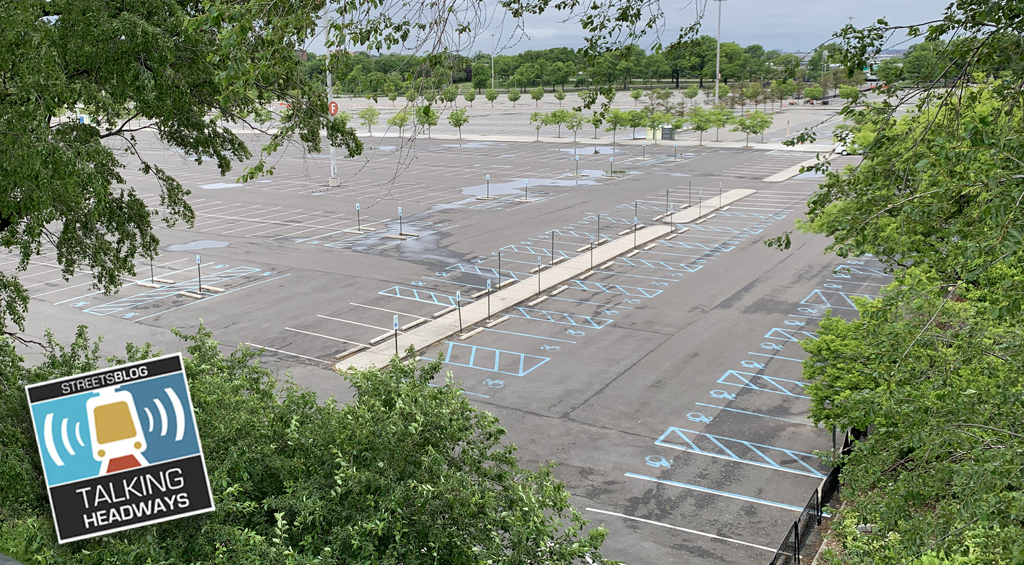When the Obama administration proposed an 18-month delay in drafting the next federal transportation bill, U.S. DOT chief Ray LaHood called for Congress to include "critical reforms" alongside the extension of the existing law. But details on those reforms have been kept under wraps -- until today.
 Transportation Secretary Ray LaHood, with his boss at right. (Photo: whitehouse via Flickr)
Transportation Secretary Ray LaHood, with his boss at right. (Photo: whitehouse via Flickr)Streetsblog Capitol Hill has obtained a copy of the item the administration wants to see added to any 18-month extension. The proposals are narrowly tailored and relatively inexpensive. Still, securing their passage could prove difficult given the House's preference for passing its new federal bill and the Senate's affinity for a "clean as a whistle" extension.
The biggest item on the administration's agenda is $310 million to help state DOTs and local Metropolitan Planning Organizations (MPOs) begin collecting data on the usage and ridership of transportation projects.
"This voluntary program would provide participating entities the opportunity
to integrate analysis into investment decisions and prepare for improved
accountability standards and merit criteria in the long-term reauthorization," the administration document states.
The administration is also seeking stricter requirements for states and MPOs to report on the costs and performance of projects that are getting federal money.
Coupled with the money for "capacity-building" at states and MPOs, the plan suggests that national performance targets -- the type proposed by Rep. Russ Carnahan (D-MO) but absent from the House's current legislation -- are on the DOT's radar as it plans for transportation reform over the next year or two.
In fact, the White House appears highly cognizant of the political blowback coming from House Democrats over its proposed delay in the transportation re-write. The $20 billion patch to the highway trust fund that Congres aims to pass by August "should be considered 'Stage I' of the broader reauthorization process," the administration document states.
But the new help for states and MPOs isn't the only transportation policy shift the administration is prepared to push for this year. A national infrastructure bank could also be on tap -- one that looks a bit different from what's proposed in the House transportation bill.
The administration's summary of its infrastructure bank plan is available in full after the jump.
BANK PURPOSE AND OBJECTIVES
Given the nation’s diverse
infrastructure needs—including energy, water, transportation, and
telecommunications—the Administration proposes the establishment of
a National Infrastructure Bank with an initial focus on transportation-related
investments and flexibility to expand to other sectors over time. This
approach will help target resources to the federal transportation funding
system, which is particularly in need of bold reform at this time. In
the meantime, the Recovery Act and other funding will help clarify the
highest-value approaches to investing in other sectors.The purpose of the Infrastructure
Bank is to establish a new direction in federal infrastructure investment:
one that supports regionally and nationally significant, high-value
projects funded through a merit-based selection process. The Bank would
fund relatively large and transformative projects currently underfunded
by the allocation process, including:
- Projects that cross
state and local jurisdictions, such as freight and passenger rail;- Projects that integrate
sectors and policy goals, such as highway projects that consider land
use and economic development; and- Projects that cross
transportation silos, such as bridge construction that includes a rail
line and harbor dredging.Merit-based project selection
would be a fundamental principle of the national Infrastructure Bank.
The Bank would compare projects of different modes, incorporating cost
effectiveness and equity considerations into its decisions.BANK DESIGN PRINCIPLES
The budget resolution adopted
by Congress includes $2 billion this year and $5 billion next year for
a national Infrastructure Bank. President Obama has outlined broad design
principles on the focus, governance structure, and financing mechanisms
of the Infrastructure Bank. The Obama Administration will work with
Congress to establish specific policies and practices for the Bank.
- Sectors for investment:
Transportation & transportation-affiliated projects. The Infrastructure
Bank should target transportation and transportation-affiliated projects
that emphasize smart land use, economic development, intermodalism,
energy conservation, and other priorities of our modern infrastructure
system. Focusing on cross-modal transportation projects with special
attention to broader economic and environmental impacts would allow
for effective targeting of Infrastructure Bank dollars. It would also
direct funds to high-value projects that are difficult to finance in
the existing system. As the Infrastructure Bank grows over time, its
scope could expand to more sectors.- Project size:
Low minimum threshold. The Administration proposes a $25 million
minimum threshold on project size. This relatively low project threshold
is consistent with the fundamental principle of merit-based selection
and would allow the Bank to choose the most valuable of a broad array
of projects. The low threshold would also help make Bank funding accessible
to all potential applicants, whether large or small, urban or rural.- Governance and
structure: Independent entity within DOT. Political independence
is critical to the success of an Infrastructure Bank. For this reason,
the Administration proposes that the Bank be housed as an independent
entity within DOT, consistent with the proposed Bank focus on transportation
and transportation-affiliated projects. The Bank would be governed by
a board of non-governmental advisors with proven expertise in infrastructure,
appointed by the President and confirmed by the Senate. Similar
to the role of the IRS Oversight Board, the Bank board would lend expertise
and insight to project selection, approve final selection decisions,
and protect the Bank from internal and external political pressures.- Financing mechanisms:
Combination of grants and credit products. A flexible set
of financing tools would allow the Bank to provide the most appropriate
form of financing to a given project. The Administration would
allow the Bank to offer a combination of grants and credit products
like direct loans and loan guarantees. The Administration does
not support Bank authority to borrow independently from private capital
markets, since Treasury is the sole entity that borrows on behalf of
the federal government and can do so more cheaply and efficiently than
any other entity.





